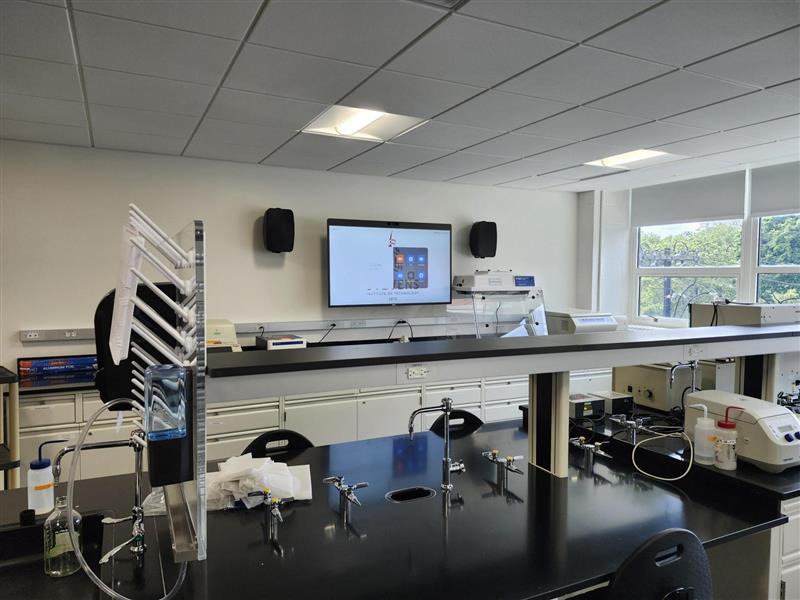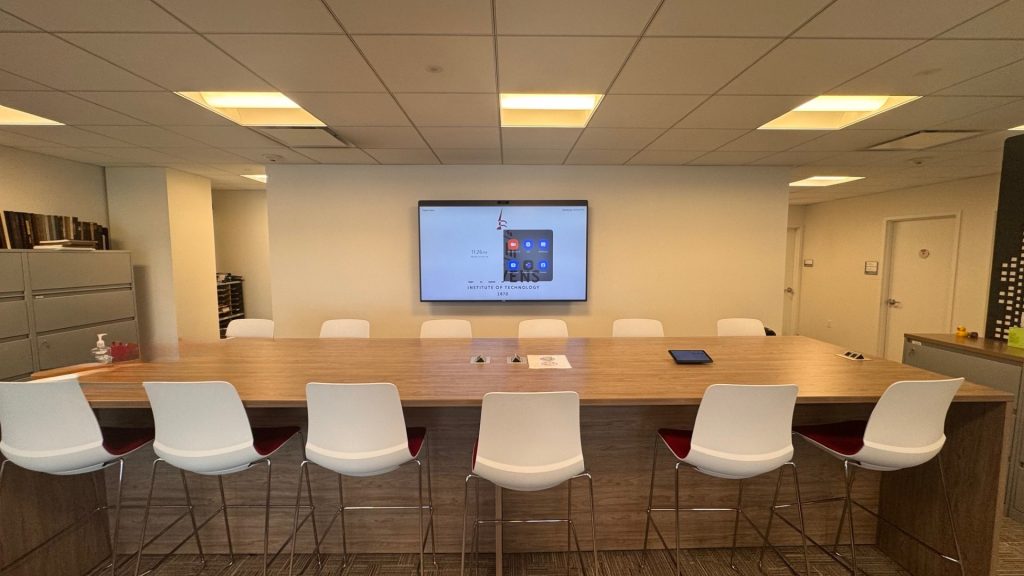Stevens Institute of Technology Speeds Installs and Reduces Support Tickets with DTEN

A patchwork of video conferencing tech created multiple points of failure for busy higher ed campus IT team
Stevens Institute of Technology is is a premier research university located in Hoboken, New Jersey. With more than 8,500 students and 600 faculty and staff across 15 academic buildings, the university’s Academic Multimedia Services team manages approximately 150 technology-enabled classrooms, labs, huddle rooms, and event spaces—an extensive technology ecosystem designed to foster collaboration and innovation.
The Challenge: Complex, Time-Consuming, and Inconsistent Room Technology
As hybrid learning and remote collaboration became central to campus life, the Stevens team faced growing challenges with maintaining and managing a patchwork of disparate technologies. “Before DTEN, we were stitching equipment together to make it work like an all-in-one system,” says Academic Multimedia Engineer Jesus Candiotti. “It required multiple devices – computers,
displays, cables – and each connection was a point of failure.
With over 150 technology-rich spaces and a lean support staff, consistency and efficiency were key pain points. “We have about 80 classrooms, 35 conference rooms, 30 labs, and several event spaces,” explains Harry Ortiz, Associate Director of Academic Multimedia Services. “Even small issues like a loose cable or software conflict could consume valuable IT time and disrupt teaching or meetings.”
Before, it could take a week to build out a conference room. Now we can do it in a day or two, sometimes less. That’s roughly a 35-40% cost savings from our previous setup.” – Harry Ortiz, Associate Director of Academic Multimedia Services
At the same time, the team wanted to streamline user experience and reduce reliance on complex setups. “We don’t like having different manufacturers floating out there,” Ortiz says. “It’s harder to support, and it’s harder for users to feel confident walking into a room and just starting a meeting.”

The Solution: Standardizing on DTEN All-in-One Devices
The breakthrough came when one of Stevens’ AV integrators invited the team to demo DTEN products at a client site in Manhattan. “Within 10–15 seconds, I had a call up and running on a system I’d never seen before,” Ortiz recalls. “That hands-on experience really got us excited.”
Starting with two test devices in their own IT department, Stevens quickly recognized the potential to simplify their AV
ecosystem. The university has since deployed DTEN D7X 55 and D7X 75 systems with DTEN Vue Pro cameras and
DTEN Mate controllers, in conference rooms, classrooms, and lab spaces.
“We’ve used nearly every DTEN model available, and all are deployed with no issues,” says Candiotti. “It’s so easy to install and manage. From a support perspective, I’ve probably gone on-site twice in five years.” The team also leverages DTEN Orbit for centralized management and remote troubleshooting. “Having management tools that actually work is essential,” says
Candiotti. “We’re really outnumbered with the number of devices we have, so being able to reboot, update, or monitor
systems remotely is huge.”

The Results: Efficiency, Savings, and Ease of Use
Stevens’ ongoing efforts to standardize on DTEN, is based on the reliability of devices as well as the quick deployment time
and cost savings. Stevens cut setup and integration time dramatically. “Before, it could take a week to build out a
conference room,” Ortiz explains. “Now we can do it in a day or two — sometimes less. That’s roughly a 35–40% cost savings
from our previous setup.”
All-in-one devices also reduced third-party installation labor, shipping costs, and network complexity. “One system, one
device,” says Candiotti. “You register it on the network, and it’s good to go.”
The team also cites the streamlined support and management they receive. With Orbit, IT staff can monitor all DTEN devices
across campus from a single interface. “When someone calls about an issue, we can check the device remotely,” Candiotti
explains. “Most times we can resolve it without even entering the room.”
Fewer moving parts have also meant fewer problems. “The lack of support tickets around DTEN is a big indicator,” Ortiz notes.
“People definitely tell us when they don’t like something, and we just don’t hear that with DTEN.”
The team agrees that DTEN provides a seamless user experience with faculty and staff easily embracing the intuitive
experience. “We trained users in one of our labs and they were blown away,” says Jesse Mottola, Academic Multimedia
Support Specialist. “They didn’t need extra instructions. Everything just made sense, and we haven’t had a single ticket
since.”
The ease of starting a meeting and collaborating naturally has made DTEN the university’s new standard. “You don’t even
think about the technology,” Ortiz says. “You just dial in and go. That’s when you know it’s working.
With strong adoption and measurable results, Stevens plans to continue expanding DTEN across campus. “Going forward, this is the standard,” Ortiz confirms. “Any space that needs hybrid capability, there’s no question, it’s going to be DTEN.”
“You don’t even think about the technology. You just dial in and go. That’s when you know it’s working. – Harry Ortiz
Read the Latest Additions to the DTEN Blog:
- Stevens Institute of Technology Speeds Installs and Reduces Support Tickets with DTEN
- Why SMBs Love DTEN
- Zoom Workplace and Self-serve Kiosks
- DTEN Launches D7X 27: Powerful All-in-One Certified Zoom Rooms Appliance for Kiosks, Huddle Spaces & Beyond
- How Huddle Room Technology is Transforming Workplaces






